Extraordinary Ecuador & the Galapagos Islands
16D / 15N


After a few days soaking up city life, get a taste of the epic outdoor adventures in the Galapagos Islands. Enjoy
snorkeling, hiking, and meeting the mellow animal inhabitants while luxuriating with calm evenings aboard a deluxe
yacht. Return to the mainland for some cultural immersion among local Ecuadorian communities who live in another
wildlife-dense pocket of the world: the Amazon jungle!
BEST TIME TO TRAVEL
DEC - MAR


IDEAL TRIP LENGTH
16 DAYS

Meet your Kuoda host upon arrival and head to your hotel where you can enjoy a restful evening before the excursions begin in the morning.
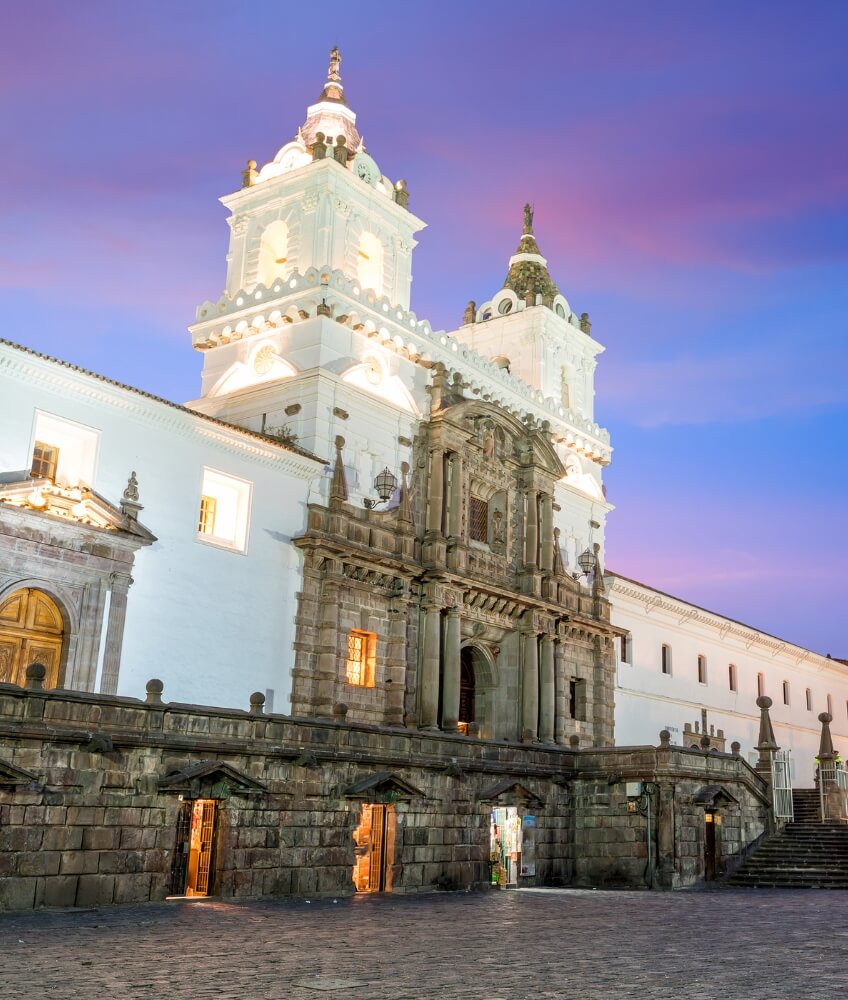
After breakfast, you will experience the luxury of a private, guided city tour – a unique way to see the best of Quito. Learn about the historical colonial churches of the old town before shopping your way across the busy outdoor markets. We’ll leave you with the evening free to relax and adjust to the altitude.

After breakfast you’ll fly to one of the few places on our planet where animals have been able to live with minimal human interference: the Galapagos Islands. The outdoor adventures begin at Baltra Island, one of thirteen major islands, surrounded by dozens of smaller islets that make up this volcanic archipelago.
A representative will meet you at the airport and escort you to the harbor, where your luxury yacht awaits. Settle in for lunch and get acquainted with the vessel during a welcome briefing for your luxury cruise of the Galapagos Islands.
In the afternoon, visit Rábida Island, one of the most volcanically varied islands in the archipelago. Stroll along Rábida’s renowned red sand beach and follow an easy trail up to a viewpoint from where you can soak up the stunning landscapes. With rare bird species including nine different finches, large-billed flycatchers, brown pelicans, and the Galapagos hawk, Rábida is beloved by birdwatchers.
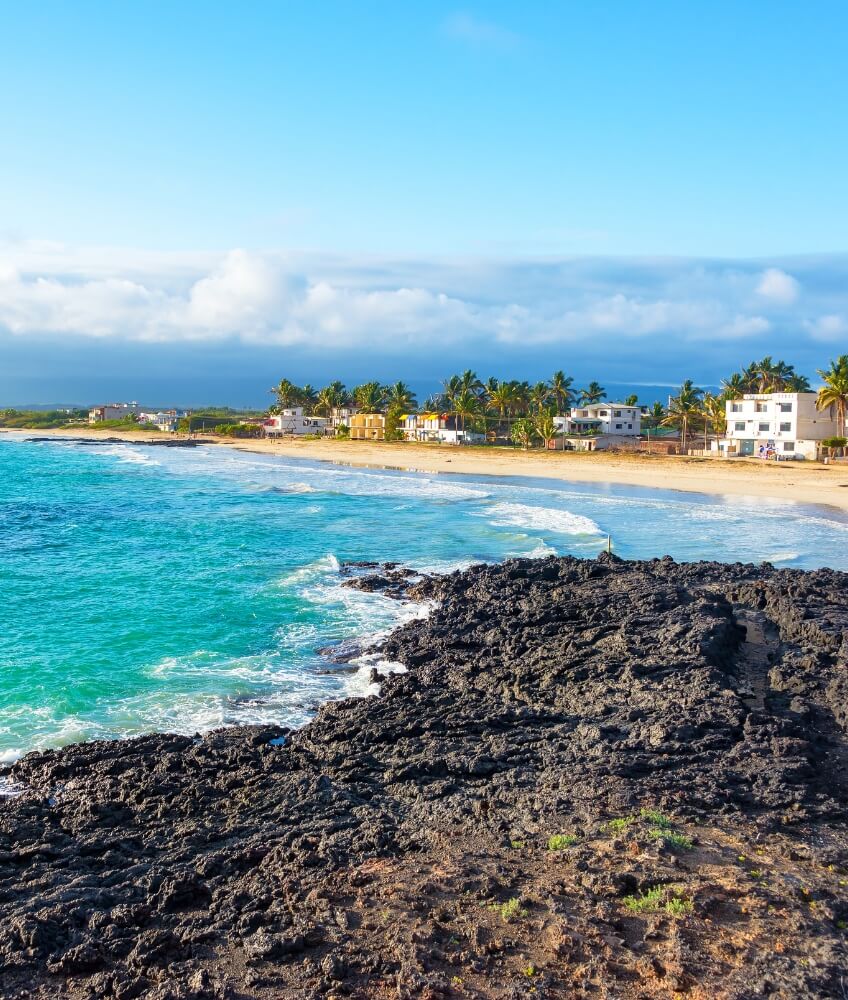
Sail to the seahorse-shaped Isabela Island, the largest and one of the most volcanically active in the archipelago. In the morning, we’ll head for the large bay of Vicente Roca Point for close encounters with seahorses, sea turtles, and the bizarre-looking mola-mola fish.
Next on the agenda is the youngest island, Fernandina, which – thanks to preservation efforts from Galapagos National Park authorities – is the most pristine ecosystem in the Galapagos. Untouched by human hands, this island has never been invaded by foreign species. Here, you can study how some of the other islands may have looked in prehistoric times. La Cumbre volcano dominates this island’s landscape, with its lava fields pooling around the shoreline.
Crossing the Bolivar Channel that divides Isabela and Fernandina Islands, you will land at Espinosa Point. Hike past a colony of marine iguanas and a group of sea lions to reach the island’s highlight – a flightless cormorant nesting site. Many of the peaceful island inhabitants are more than willing to come right up close to humans, so get ready to make some new friends here.
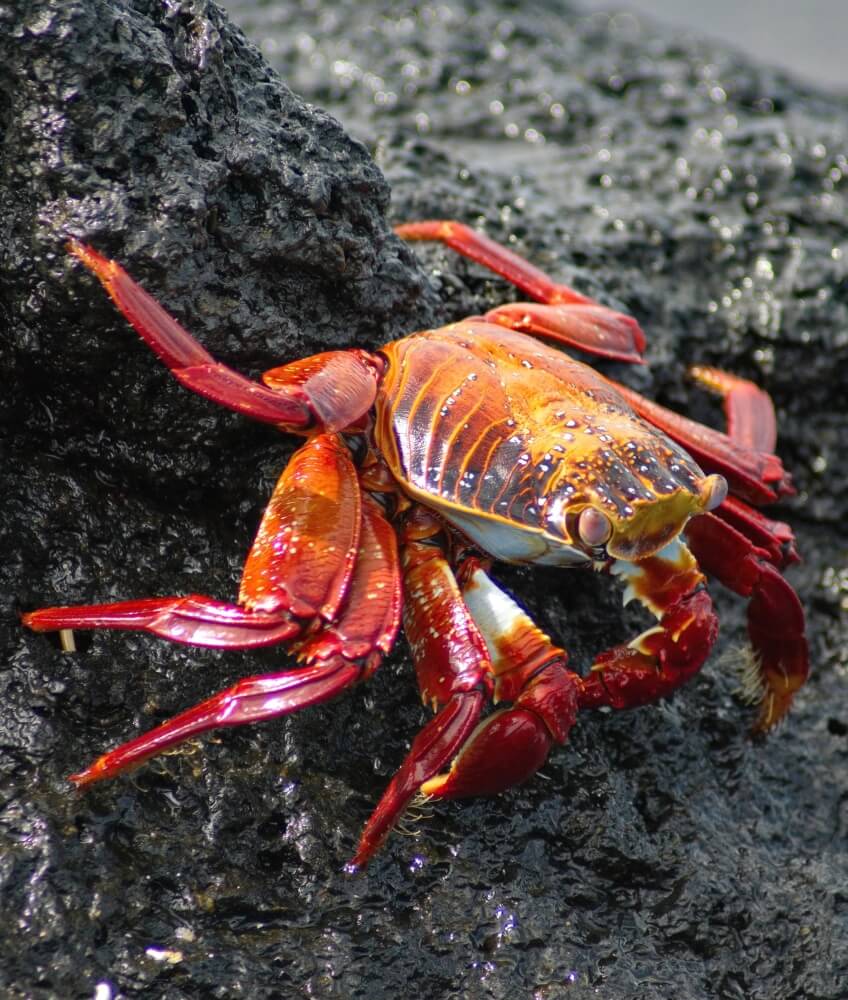
This morning you’ll visit Tagus Cove’s ‘cliff-side gallery’ to see some early graffiti work. These etchings in the rock are the work of Victorian-era pirates who inscribed their names on the earth during the 1830s. The 19th-century vandalism contrasts starkly with the untouched environment around it, making visitors contemplate the impact of human activity on the area.
From Tagus Cove, you’ll trek along a 1.25-mile route through lava formations to reach Darwin Lake. Scientists believe this saltwater crater lake may have been filled by a tidal wave brought on by a volcanic eruption.
In the afternoon you’ll be brought to Urbina Bay, a flat area formed by tectonic shifting in 1954. As a result, the region is home to some fascinating geological formations. Explore the area and you may be able to spot more wildlife, including stingrays and turtles gliding beneath the water, while flightless cormorants, pelicans, and marine iguanas convene on shore.
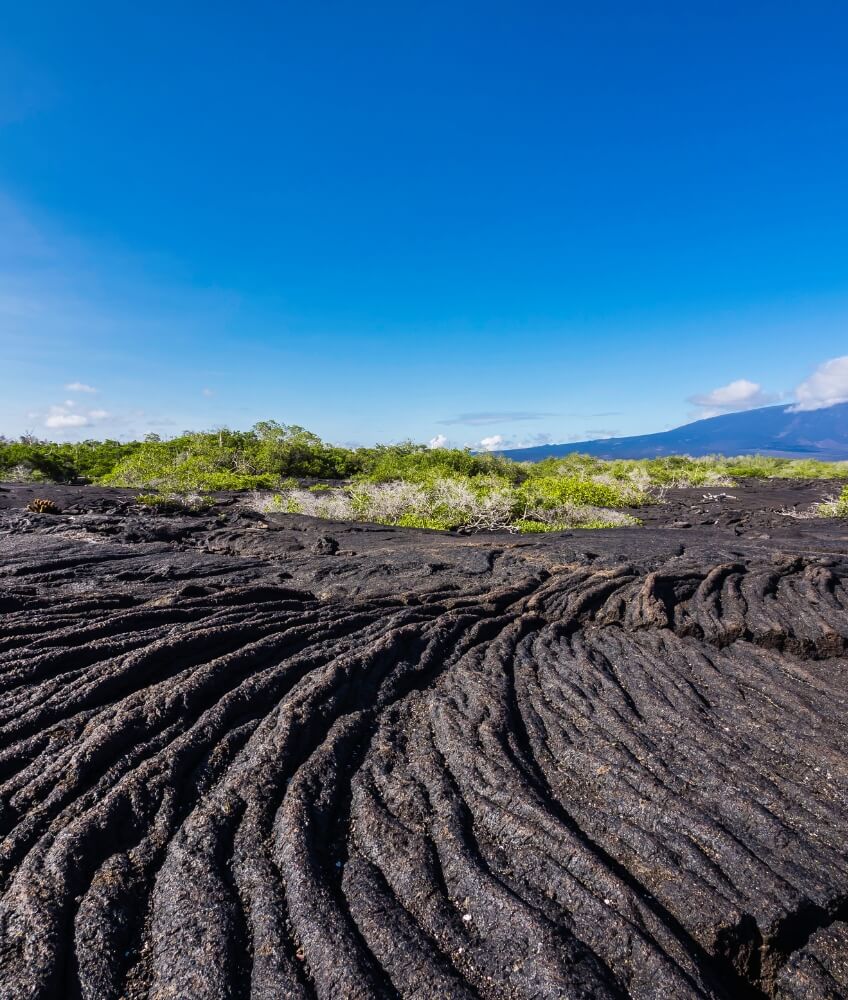
Sail on your luxury Galapagos cruise to Elizabeth Bay. This isolated spot has no landing sites for boats so you’ll have to take a traditional ‘panga’ ride to properly explore. Skim past red mangroves and peer over the boat’s edge to spot sea turtles and rays dancing underwater, brown pelicans plunging beneath the waves in the search for food, or even a humpback whale on its ocean voyage.
In the afternoon you will visit Moreno Point where a dry lava field landing is possible. After disembarking, hunt around the tide pools to see what kinds of marine life drift into view. The waters here are frequented by pink flamingos and white-cheeked pintails, with the occasional sea turtle and white-tip reef shark swimming around.

Prepare for more amazing encounters at the wetlands near Puerto Villamil on Isla Isabela. Behind the white-sand beaches stretching out from the port is a lagoon perfect for birdwatching. Flamingos, stilts, whimbrels, and gallinules among them are just a few of the species that come to relax here, comfortable with observers who want to watch their peaceful daily routines.
Next, you’ll head to the Wall of Tears (El Muro de las Lágrimas) to reflect upon an important piece of island history. The monument honors the penal colony that existed in Isabela from 1945 to 1959, and the suffering of the prisoners who were held there. Thousands of these prisoners died during the construction of the 65-foot stone wall, which now stands in remembrance of the lives lost.
Later you will visit Centro de Crianza and the Arnaldo Tupiza Giant Turtle breeding center found just one mile from Villamil. This research center will provide you with a rare opportunity to watch hatchlings from two of the five surviving giant turtle sub-species. They are brought here to protect them during the first, most vulnerable years of their life as their natural environment has been threatened by the introduction of foreign animals, such as pigs and donkeys. Park keepers gather the turtle eggs from the wild and bring them to incubate at the center. After five years, when the turtles are capable of surviving in the wild, they are released back to their natural habitat.
While you’re here, stroll around the breeding center’s gardens to learn about some special plant species like chamomile, Algarrobo, cactus, cat claw, Chala, and horse knee.

In the morning, you’ll sail to North Seymour Island where Galapagos sea lions, blue-footed boobies, and magnificent frigate birds all lounge around enjoying early sunshine.
Embark on a short hike in the afternoon to Los Gemelos, colloquially known as “the Twins.” The twins are a pair of sinkholes, created by the collapse of surface material into underground fissures and chambers. Flying around the nearby Scalesia Forest are vermillion flycatchers, short-eared owls, and finches.
Next, you’ll head to the Fausto Llerena breeding center, part of the Charles Darwin Research Station. This is a sanctuary for juvenile tortoises ranging from three-inch hatchlings to older four-foot denizens. The babies are kept here until about four years old when they are large enough to survive in the wild. Discover the various sub-species of tortoises and watch how they interact with each other. One may even decide to come to say hello to you! Many of the older tortoises are used to having humans around and will stretch out their heads for a gentle pat.

Visit the southernmost island of the Galapagos, Española Island, the breeding ground for almost all of the world’s 24,000 waved albatrosses. With that many winged creatures crowding the island, you might think there was no room left for more feathered locals. But you’d be wrong: Española is also densely populated with mockingbirds, blue-footed and Nazca boobies, Darwin finches, Galapagos doves, and hawks. It’s a lively community that animal-loving travelers will find fascinating.
In the morning, you will start with a pleasant hike at Suarez Point and say hello to a few of these bird species. You will also visit a beautiful site on the oceanfront, with a cliff that large albatrosses use as a flight launch pad. Bring your camera along to take photos of the island’s iconic blowhole, which spits water high up into the air like a strange geyser.
During the afternoon, kick off your shoes and stroll around the white-sand beach of Gardner Bay. Be careful not to trip over any of the lolling sea lions soaking up the sun here. Take a dive in the water and some adorable sea lion pups may join you.

Enjoy one last Galapagos adventure at the Galapaguera de Cerro Colorado conservation area and the Interpretation Center on San Cristobal Island. Just a quick stroll around the area will provide unique wildlife observation. You’ll see warblers, finches, and mockingbirds perched on trees and shrubs, while giant tortoises may even roam onto your path. These giant tortoises are wild but live in a sealed-off area designed to protect them from predators. They rarely perceive humans as dangerous, but if they do, you’ll be able to tell as they retreat into their hard shells.
After this visit, you will be transferred to San Cristobal’s airport in time to catch your flight back to the mainland. In Quito, your guide will be waiting at the airport to transfer you to your hotel.

After breakfast your guide will take you on the ultimate shopping excursion to Otavalo Market, which has been running since pre-Inca times. Famous for being South America’s oldest market, this is more than a fun place to shop for souvenirs – it’s a living museum!
Located in the prosperous indigenous community of Otavalo, this market offers many colorful handicrafts from local artisans including the famous Ponchos’ Market! Make a pit stop at Cotacachi to see its famous handcrafted leather goods, before visiting Cuicocha Lake in the Cotacachi Cayapas Ecological Reserve. From there, continue to Cuicocha, which lies inside the crater of an active volcano and is surrounded by flora and fauna. This place is considered sacred and, at certain times of the year, the native people celebrate traditional rituals to purify their souls. After this, you will return to Quit for a relaxing evening.

Today is a free day to explore the capital city of Quito! Discover a world of secrets and stunning scenery in this historic town.

After breakfast, you’ll head to the airport for a quick 35-minute flight to Coca. This journey traverses both the Eastern Andes and the equator, so you may be able to see volcanic peaks from the plane window. Soon, you’ll reach the headwaters of the Amazon Basin, near the Napo River.
At Coca’s airport, a representative of Napo Wildlife Center will greet you and drive you to the pier, where a motorized canoe will be waiting. Set off on a 3-hour journey along Napo River to reach a creek, where you’ll switch to a small dugout canoe for the final leg. A delicious packed lunch will provide you ample energy for this excursion, and by the time you arrive at the lodge in the afternoon, you’ll be ready to relax before the jungle activities tomorrow.

During these two days, you’ll get to explore the jungle with a real expert: a local Añangu guide, who is also an official Yasuni Park Ranger. The native Añangu people participate actively in the conservation and management of large parts of the park. Your guide will be able to show you the interesting, plants, and exotic wildlife of the rainforest, explaining how the interdependent nature systems work here.
Start at the parrot clay lick, where a crowd of colorful birds gathers to ingest the mineral-rich clay. The lick is located at Napo and can be reached via a short downstream canoe ride down Giant Otter creek.
Next, you can ascend to the top of the 50-foot observation tower built on a 42-foot hill. From the highest point of this tower, you will be at eye level with passing troops of spider or howler monkeys swinging through the trees. This is a breathtaking way to get the ultimate rainforest views, enjoy some birdwatching, and marvel at the vast expanse of the Amazon.
Follow your guide into the depths of the jungle during hikes along forested trails. Guides will help you navigate the sights, smells, and sounds of the jungle so you can spot camouflaged creatures, identify bird songs, and study the unique tropical plants. And in the Amazon, always expect the unexpected. You never know when one of the largest mammals, such as the jaguar, puma, tapir, giant anteater, or giant armadillo, may step out onto your path.
During your private tour of the Amazon, Kuoda can also arrange encounters that will allow you to join indigenous Añangu communities as they go about their daily activities. Help them harvest bananas, coco, and manioc – a starchy jungle root and food staple for Amazonian people – and learn how to prepare chicha, a traditional drink based on fermented manioc. If you like fishing, you can try to catch your own using aboriginal techniques, with the assistance of skilled locals.
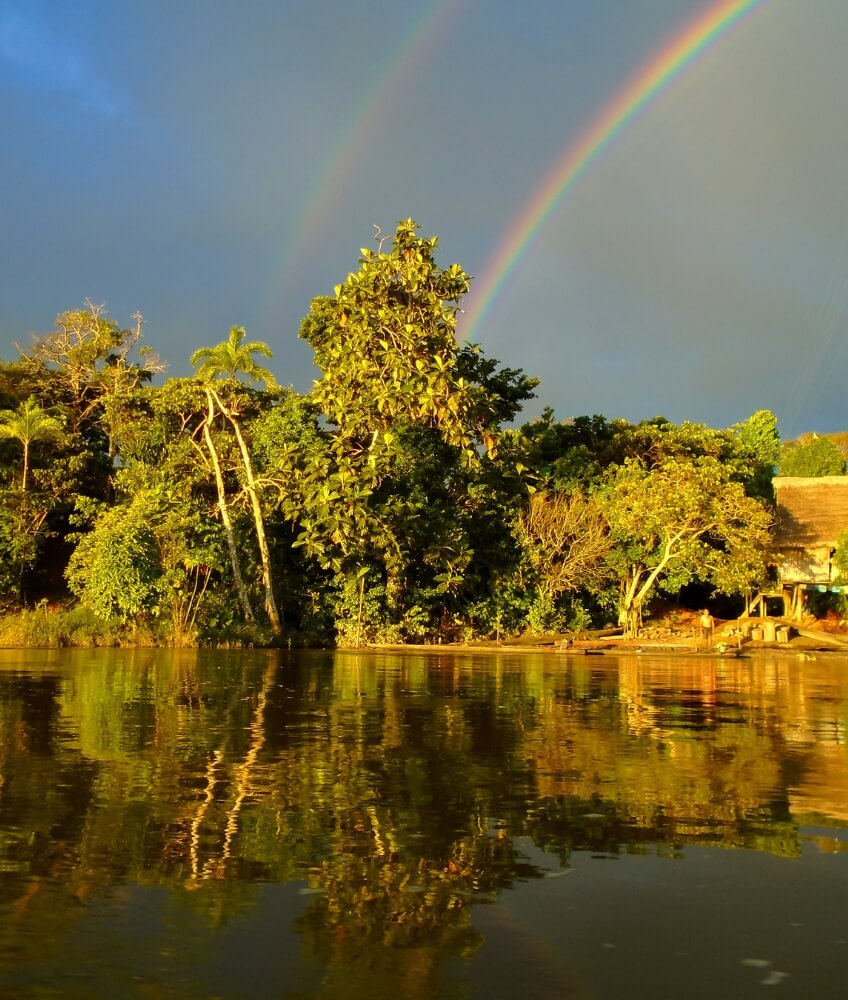
After one last jungle breakfast, you’ll depart for Coca and from there, fly to Quito. A boxed lunch is provided en route to keep hunger at bay. At the airport, your guide will be waiting to bring you to your hotel, where you’ll stay before catching your international flight home. Buen Viaje!
Each journey is tailored to your specific needs and desires, and so our prices vary depending on the number of people
traveling, level of accommodations desired, and activities included, among other factors.
Our travel designers will curate a journey specifically for you. If you have a budget you want us to work with, please let
us know, and we will do our best to achieve it.
From luxury properties to boutique hotels, our staff handpicks your ideal stay to ensure you get the ultimate comfort during your travels.
By submitting this form, you agree that we may contact you about your inquiry and send additional travel information and news from which you may unsubscribe at any time.
By submitting this form, you agree that we may contact you about your inquiry and send additional travel information and news from which you may unsubscribe at any time.

This sample Ecuador luxury tour focuses on the culturally rich and less-often explored Ecuadorian countryside. Start your private…

Embark on a journey between the culturally rich mainland and the extraordinary Galapagos Islands with a luxury tour…

Experience a luxury tour of Ecuador that will connect you with some of the country’s most exciting sights, sounds, and experiences…
Peru’s rich heritage is brought to life through its vibrant handicrafts. From colorful textiles to intricate...
Read PostBask in the northern BEACHERGOER’S PARADISE, With its dependable year-round sunshine, pristine coastline, s...
Read PostImagine a family vacation in South America where your family explores sun-drenched beaches in Colombia and Per...
Read Post